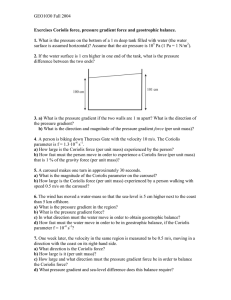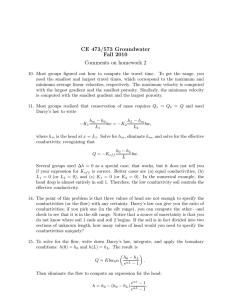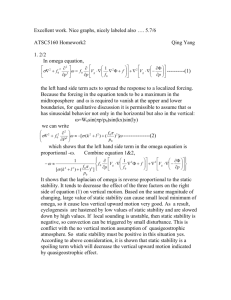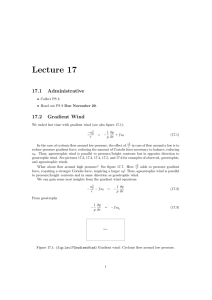Lecture 16 16.1 Administrative 16.2
advertisement
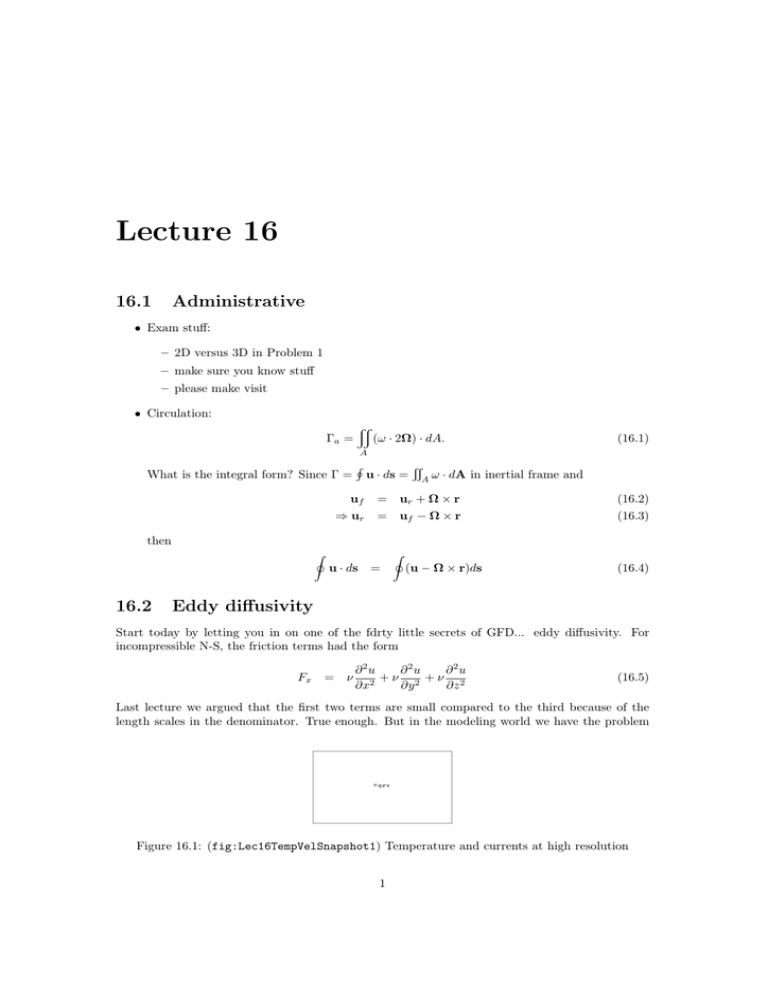
Lecture 16 16.1 Administrative • Exam stuff: – 2D versus 3D in Problem 1 – make sure you know stuff – please make visit • Circulation: Γa = (ω · 2Ω) · dA. (16.1) A What is the integral form? Since Γ = uf ⇒ ur then u · ds = A ω · dA in inertial frame and = ur + Ω × r = uf − Ω × r (16.2) (16.3) u · ds = 16.2 (u − Ω × r)ds (16.4) Eddy diffusivity Start today by letting you in on one of the fdrty little secrets of GFD... eddy diffusivity. For incompressible N-S, the friction terms had the form Fx = ν ∂2u ∂2u ∂2u + ν + ν ∂x2 ∂y 2 ∂z 2 (16.5) Last lecture we argued that the first two terms are small compared to the third because of the length scales in the denominator. True enough. But in the modeling world we have the problem Figure 16.1: (fig:Lec16TempVelSnapshot1) Temperature and currents at high resolution 1 Figure 16.2: (fig:Lec16TempVelSnapshot2) Temperature and currents at low resolution Figure 16.3: (fig:Lec16Mixing) Comment of isopychal mixing: Really, ν is huge along constant density surfaces, and tiny across constant density surfaces. Because constant density surfaces slope, end up with large νH and νV . of unresolved scales. There is all kinds of stuff happening on spatial scales smaller than our grid spacing (see figures 16.1 and 16.2). So, to model the impact of these unresolved scales, we put in an artificial viscosity: Fx = νH ∂2u ∂2u ∂2u + ν + ν H V ∂x2 ∂y 2 ∂z 2 (16.6) where νH and νV differ by 3 or 4 orders of magnitude, and νH and ν differ by ∼ 7 orders of magnitude (see figure 16.3 for note on isopycnal mixing). 16.3 Balances in the simplified momentum equations We’re going to spend the next two or three lectures looking at “balances” in the simplified momentum equations. Ignoring viscosity for now: Du 1 =− Dt ρ Dv 1 =− Dt ρ ∂p + fv (16.7) ∂x ∂p y: − fu (16.8) ∂y ∂p z: 0=− − pg (16.9) ∂z The assumptions that went into deriving these equations are no viscosity, incompressible, no curvature terms, no vertical coriolis terms, and no vertical rates of change (these last two correspond to hydrostatic balance). x: 16.4 f -plane Note that f = 2Ω sin φ is a function of latitude. If the time-scales are long and/or the spatial scales are large, then the latitudinal dependence is important. But we can often assume that the coriolis parameter is constant: f0 = 2Ω sin φ0 where φ0 is a reference latitiude. This is the f -plane approximation (Q1). 2 (16.10) Figure 16.4: (fig:Lec16BetaPlane) Relating small changes in latitude to small changes in y. 16.5 β-plane If latitudinal changes are likely to be important, but we can restrict ourselves to an area near a reference latitude, then we can allow the coriolis parameter to vary linearly with y Perform a Taylor expansion about some reference latitude: f = f (φ) = 2Ω sin φ f (φ0 + ∆φ) = f (φ0 ) + f (φ0 )∆φ = f0 + 2Ω cos φ0 ∆φ (16.11) (16.12) (16.13) Noting figure 16.4, we get: f = fo + 2Ω cos φo f = fo + f Where β = 16.6 2Ω cos φo . r y r 2Ω cos φo y r = fo + βy (16.14) (16.15) (16.16) This is the β-plane approximation. Recap of approximations to f Back to our simplified momentum equations. x: y: Du 1 =− Dt ρ Dv 1 =− Dt ρ ∂p + fv ∂x ∂p − fu ∂y ∂p 0 =− − pg ∂z z: (16.17) (16.18) (16.19) (16.20) Here f could be f f f = 2Ω sin φ = f0 + ρy = f0 (16.21) (16.22) (16.23) We’ll stick with f0 for a while. There are many many things to say about these equations. A huge amount of observed geophysical flows can be described by further simplifications of these already simplified equations. 3 16.7 Inertial circles We’ve already talked about one simplification. In local cylindrical coordinates: ∂ur u2 + (u · ∆)ur − θ ∂t r = − 1 ∂p + f uθ ρ ∂r (16.24) Inertial circles have no ur , only uθ , and there is no pressure gradient force. We are left with the “balance” −u2θ r (16.25) = f uθ This describes the observed inertial circles, and gave us the period of 12 day. Remember that? (Q2). Strictly, I probably shouldn’t call this a balance. Balances are between forces, this is an F = ma expression. 16.8 Geostophic balance This next simplification really does result in a proper balance. Du 1 =− Dt ρ Dv 1 =− Dt ρ x: y: ∂p + fv ∂x ∂p − fu ∂y (16.26) (16.27) (16.28) The easy way out is to say we want to look at the time-invariant flow, so This leaves us with: x: y: 1 ρ 1 ρ ∂p ∂x ∂p ∂y Du Dt = 0 by definition. = fv (16.29) = −f u (16.30) (16.31) This is a balance between the pressure gradient force and the coriolis force. It is called the geostrophic balance or the concept of geostrophy. Before saying more about the balance, lets get a feel for the situations in which we can expect geostrophic flow. Write down the simplified xmomentum equation: x: ∂u + (u · ∇)u ∂t U U U2 U2 = = T L/U L L = 1 ∂p + fv ρ ∂x (16.32) fU (16.33) When is it okay to ignore the LHS? The terms of the LHS are order To ignore LHS, we need U2 L U fL fU 1 4 u2 L, the coriolis term is f U . (16.34) (Q4) (16.35) Figure 16.5: (fig:Lec16GeostrophicForceBalance) Geostrophic force balance (Q3). Figure 16.6: (fig:Lec16EqPoleTemp) Equator-pole temperature difference and its importance to geostrophy. But U = R0 fL (16.36) Remember the Rossby number? So we can only ignore the LHS for R0 1 ⇒ impact of rotation is important relative to time rates of velocity. R0 1 for mid-latitude, large scale features. Back to geostrophy: Balance between the pressure gradient force and the coriolis force. Imagine a pressure gradient as is seen in figure 16.5. This will drive a flow in the +y direction. In the northern hemisphere, this flow will be deflected to the right, and will continue to deflect until the pressure gradient force balances the coriolis force. This will happen when the flow is parallel to lines of constant pressure. This same result is seen in the math: 1 ∂p + fv ρ ∂x 1 ∂p − − fu ρ ∂x 1 ∂p f ρ ∂x 1 ∂p − f ρ ∂y 1 k × ∇p fρ 0 = − (16.37) 0 = (16.38) ⇒ v = ⇒ u = ⇒ ug = (16.39) (16.40) (16.41) Here ug = geostrophic velocity. Note that this equation says ug is perpendicular to the pressure gradient. In the atmosphere, you have heating at the equator and cooling at the poles (see figure Figure 16.7: (fig:Lec16HorizontalSlice) Plane view of horizontal slice from 16.6. 5 16.6). So the height of a pressure surface is lower at the poles then at the equator. Take a horizontal slice through these pressure surfaces and look at the plan view (see figure 16.7). The horizontal pressure decreases as we go from the equator to the pole, so the resulting geostrophic flow is westerly, explaining our prevailing winds in the Northern Hemisphere. Is this what we see in the observation? Yes, but before I show you any observations, let me talk a bit about pressure as a vertical coordinate. Consider: ∂p |z ∂x (16.42) From hydrostatic, know p = p(z), hence for constant z we must use the chain rule ∂p |z ∂x = − ∂p ∂z ∂p ∂ρ |x |p + ∂z ∂x ∂ρ ∂x (16.43) Note that the negative sign is because pressure decreases at z increases. Also, we can ignore the last term if we have a constant density. Next, the hydrostatic balance says: ∂p ∂x Substitute into ∂p ∂x equation: ∂p ∂x x: = −ρg ∂z = ρg ∂x |p : 1 ∂p = fv ρ ∂x ⇒ ⇒ y: 1 ∂p = −f u ρ ∂y ⇒ ⇒ ∂z ρg = fv ∂x g ∂z v= |p f ∂x ∂z 1 ρg = −f u ρ ∂y g ∂z u=− |p f ∂y 1 ρ (16.44) (16.45) (16.46) (16.47) (16.48) Thus, ug = ug = g k × ∇z|p f 1 k × ∇p|z pf (16.49) (16.50) For the first equation, p is the independent variable, and z is the dependent variable. Instead of z, which can be confusing, call it h for height: ug = fg k × ∇h|p . Show observations of geostrophic balance. See figures 16.8 through 16.14. 16.9 Ageostrophic flow So the observed flow is largely geostrophic, but there are areas where there is significant ageostrophic flow. What could be causing this? Well, lots of stuff... all the stuff we’ve left out. But concentrate on the simplified equations we started with: ∂u 1 ∂p ∂u ∂u ∂u x: = − +u + + + fv (16.51) ∂t ∂x ∂y ∂z ρ ∂x 1 ∂p ∂u ∂u ∂u ∂v = − +v + + − fu (16.52) y: ∂t ∂x ∂y ∂z ρ ∂y 6 Figure 16.8: (fig:Lec16HeightSurfaces) Height p like, log p if z like. So we do see higher pressure South and lower pressure North (follow a constant pressure, horizon, line). Figure 16.9: (fig:Lec16Observed1) Case 1: Observed winds. Note contours are height of 500 mb surface, units are m/s. Figure 16.10: (fig:Lec16Geostrophic1) Case 1: Geostrophic winds. Figure 16.11: (fig:Lec16Ageostrophic1) Case 1: Ageostrophic winds Figure 16.12: (fig:Lec16Observed2) Case 2: Observed wind Figure 16.13: (fig:Lec16Geostrophic2) Case 2: Geostrophic winds. 7 Figure 16.14: (fig:Lec16Ageostrophic2) Case 3: Ageostrophic winds. Figure 16.15: (fig:Lec16CylindricalCoordinates) Gradient wind is best thought of in terms of gradient wind. We will next talk about the bit of the ageostrophic wind that comes from the comes from the u · ∇u term. 16.10 ∂ ∂t , and the bit that Gradient Wind Where the geostrophic wind is a two-way balance between the coriolis force and the pressure gradient force, the gradient wind is a three-way “balance” between the coriolis force, the pressure gradient force and the centrifugal force. Because we’re dealing with centrifugal force, it will be easiest to think of things in cylindrical coordinates (see figure 16.15). Du r Dt r: = 1 ∂p + f uθ ρ ∂r (16.53) Expanding the LHS gives ∂ur u2 + u · ∇ur − θ ∂t r = − 1 ∂p + f uθ ρ ∂r (16.54) Assume steady and neglect nonlinear advections − u2θ r = − 1 ∂p + f uθ ρ ∂r (16.55) or in terms of forces − 1 ∂p u2 + f uθ + θ = 0 ρ ∂r r (16.56) The second terms is the Coriolis bit which (see figure 16.15) in the direction of +r which means that the term is greater than 0. The third terms is the centrifugal bit. It is alway positive and in direction of +r. The first term, which here must balance the last two terms, is the pressure gradient bit. To balance ∂p ∂r must be greater than zero to that there is increasing pressure with increasing r. How do we expect the gradient flow to compare with the geostrophic flow? See figures 16.16 and 16.17. The centrifugal force effectively reduces the pressure gradient force, which means that 8 Figure 16.16: (fig:Lec16Anticyclone) Gradient wind balance in an anticyclone. Figure 16.17: (fig:Lec16Cyclone) Gradient wind balance in a Cyclone. the coriolis force in the gradient flow is less than for geostrophy, so uθ in the gradient flow is less than the geostrophic uθ (for flow around a low). Look for this in observations. Note that the ageostrophic flow is along pressure (or height lines). Generically, u2θ − f uθ r and from geostrophy; − ρ1 16.11 ∂p ∂r = − = −f uθ Reading None assigned in this lecture. 9 1 ∂p ρ ∂r (16.57)


